Chemnitz
| Chemnitz | |||
|---|---|---|---|
    From top: View over Chemnitz, Red tower, Old Town Hall, Modern city centre of Chemnitz | |||
| |||
 Chemnitz | |||
| Coordinates: 50°50′N 12°55′E / 50.833°N 12.917°ECoordinates: 50°50′N 12°55′E / 50.833°N 12.917°E | |||
| Country | Germany | ||
| State | Saxony | ||
| District | Urban districts of Germany | ||
| Government | |||
| • Mayor | Barbara Ludwig (SPD) | ||
| Area | |||
| • Total | 220.85 km2 (85.27 sq mi) | ||
| Elevation | 296 m (971 ft) | ||
| Population (2017-12-31)[1] | |||
| • Total | 246,855 | ||
| • Density | 1,100/km2 (2,900/sq mi) | ||
| Time zone | CET/CEST (UTC+1/+2) | ||
| Postal codes | 09001–09247 | ||
| Dialling codes |
0371 037200 (Wittgensdorf) 037209 (Einsiedel) 03722 (Röhrsdorf) 03726 (Euba) | ||
| Vehicle registration | C | ||
| Website |
www | ||
Chemnitz (German: [ˈkɛmnɪts] (![]()
Etymology
Chemnitz is named after the river Chemnitz, a small tributary of the Zwickau Mulde. The word "Chemnitz" is from the Sorbian language (Upper Sorbian: Kamjenica), and means "stony [brook]". The word is composed of the Slavic word kamen meaning "stone" and the feminine suffix -ica.
It is known in Czech as Saská Kamenice and in Polish as Kamienica Saska. There are many other towns named Kamenica or Kamenice in areas with past or present Slavic settlement.
History

An early Slavic tribe's settlement was located at Kamienica, and the first documented use of the name Chemnitz was the 1143 site of a Benedictine monastery around which a settlement grew. Circa 1170 Frederick I, Holy Roman Emperor granted it the rights of an Imperial city. In 1307, the town became subordinate to the Margraviate of Meissen, the predecessor of the Saxon state. In medieval times, Chemnitz became a centre of textile production and trade. More than one third of the population worked in textile production.
By the early 19th century, Chemnitz had become an industrial centre (sometimes called "the Saxon Manchester"). In 1913, Chemnitz had a population of 320,000 and, like Leipzig and Dresden, was larger at that time than today. After losing inhabitants due to the First World War Chemnitz grew rapidly again and reached its all-time peak of 360,250 inhabitants in 1930. Before the world economic crises, it was supposed that the city would keep on growing and would become a Millionenstadt (English: Megacity, literally: city with at least one million inhabitants) by incorporating also fast growing smaller towns and municipalities around it.
Weimar Republic
As a working-class industrial city, it was a powerful center of socialist political organization after World War I. At the foundation of the German Communist Party the local Independent Social Democratic Party of Germany voted by 1,000 votes to three to break from the party and join the Communist Party behind their local leaders, Fritz Heckert and Heinrich Brandler.[2] In March of 1919 the German Communist Party had over 10,000 members in the city of Chemnitz.[3]
World War II
Allied bombing destroyed 41% of the built up area of Chemnitz during the Second World War.[4] Chemnitz contained factories that produced military hardware and a Flossenbürg forced labor subcamp (500 female inmates) for Astra-Werke AG.[5] The oil refinery was a target for bombers during the Oil Campaign of World War II, and Operation Thunderclap attacks included the following raids:
- 14/15 February 1945: The first major raid on Chemnitz used 717 RAF bombers, but due to cloud cover most bombs fell over open countryside.
- 2/3–5 March: USAAF bombers attacked the marshalling yards.[6]
- 5 March: 760 RAF bombers attacked.
The headquarters of the auto manufacturer Auto Union were also based in Chemnitz since 1932 and its buildings were also badly damaged. At the end of the war, the company's executives fled and relocated the company in Ingolstadt, Bavaria, where it evolved into Audi, now a brand within the Volkswagen group.
The World War II bombings left most of the city in ruins, and post-war, the East German reconstruction included large low rise (and later high-rise Plattenbau) housing. Some tourist sites were reconstructed during the East German era and after German reunification. The city was occupied by Soviet troops on 8 May 1945.
East Germany
After the dissolution of the Länder (states) in the GDR in 1952, Chemnitz became seat of a district (Bezirk). On 10 May 1953, the city was renamed by decision of the East German government to Karl-Marx-Stadt after Karl Marx, in recognition of its industrial heritage and the Karl Marx Year marking the 70th anniversary of his death.[7] GDR Prime Minister Otto Grotewohl said:
The people who live here do not look back, but look forward to a new and better future. They look at socialism. They look with love and devotion to the founder of the socialist doctrine, the greatest son of the German people, to Karl Marx. I hereby fulfill the government's decision. I carry out the solemn act of renaming the city and declare: From now on, this city bears the proud and mandatory name Karl-Marx-Stadt.[8]
After the city centre was destroyed in World War II, the East German authorities attempted to rebuild it to symbolise the conceptions of urban development of a socialist city. The then layout of the city centre was rejected in favour of a new road network. However, the original plans were not completed. In addition, the rapid development of housing took priority over the preservation of old buildings. So in the 1960s and 1970s, both in the centre as well as the periphery, large areas were built in Plattenbau apartment-block style, for example Yorckstraße. The old buildings of the period, which still existed in the Kassberg, Chemnitz-Sonnenberg and Chemnitz-Schloßchemnitz especially, were neglected and fell increasingly into dereliction .
After reunification

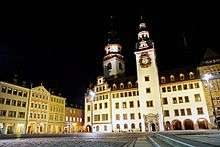
On 23 April 1990, a referendum on the future name of the city was held: 76% of the voters voted for the old name "Chemnitz". On 1 June 1990, the city was officially renamed.
After the reunification of Germany on 3 October 1990, the city of Chemnitz faced several difficult tasks. Many inhabitants migrated to the former West Germany and unemployment in the region increased sharply; in addition Chemnitz did not have adequate shopping facilities, but this was increasingly demanded.[9] Large shopping centers were constructed on the city periphery to the early 1990s.
Chemnitz is the only major German city whose centre was re-planned after 1990, similar to the reconstruction of several other German cities in the immediate post-war years. Plans for the recovery of a compressed city centre around the historic town hall in 1991 led to an urban design competition. This was announced internationally by the city and carried out with the help of the partner city of Düsseldorf. The mooted project on an essentially unused area of the former city would be comparable in circumference with the Potsdamer Platz in Berlin.[9]
Numerous internationally renowned architects such as Hans Kollhoff, Helmut Jahn and Christoph Ingenhoven provided designs for a new city centre. The mid-1990s began the development of the inner city brownfields around the town hall to a new town. In Chemnitz city more than 66,000 square meters of retail space have emerged. With the construction of office and commercial building on the construction site "B3" at the Düsseldorf court, the last gap in 2010 was closed in city centre image. The intensive development included demolition of partially historically valuable buildings from the period and was controversial.[10][11] Between 1990 and 2007 more than 250 buildings were leveled.
In late August of 2018 the city was the site of a series of protests that attracted at least 8,000 people. The protests were also attended by some far-right and Neo-Nazi groups. News outlets reported about mob violence and riots. The protests started after two immigrants were arrested in connection with the murder of Daniel H., a 35 year old Cuban-German man, which had happened on 26 August. Violent clashes occurred between far-right protesters and far-left counter protesters, leading to injuries. The mobs outnumbered the local police presence. There were reports that rightist protesters chased down dark skinned bystanders and those that appeared to be foreigners on the streets before more police arrived and intervened. The riots were widely condemned by media outlets and politicians throughout Germany, and were "described as reminiscent of civil war and Nazi pogroms."[12][13][14][15]
The reports of mob violence and riots were criticized as incorrect later on. The German language Swiss newspaper Neue Zürcher Zeitung corrected its earlier reports, stating that there had evidently been no mob violence but there have been sporadic encroachments.[16] Minister President of Saxony Michael Kretschmer came to the same conclusion: "there were no mobs and man hunts".[17]
One week after the protests, a free "Concert against the Right" under the motto "We are more" (#wirsindmehr) attracted an audience of some 65,000 people.[18] A one-minute silence commemorated Daniel H., the Cuban-German man killed [19]. The concert itself has been criticized for far-left activities and violent song texts of some of the participating bands[20][21].
Culture and sights
Theater Chemnitz offers a variety of theatre: opera, plays, ballet and Figuren (puppets), and runs concerts by the orchestra Robert-Schumann-Philharmonie.
Tourist sights include the Kassberg neighborhood with 18th and 19th century buildings and the Karl Marx Monument by Lev Kerbel, nicknamed Nischel (a Saxon dialect word for head) by the locals. Landmarks include the Old Town Hall with its Renaissance portal (15th century), the castle on the site of the former monastery, and the area around the opera house and the old university. The most conspicuous landmark is the red tower built in the late 12th or early 13th century as part of the city wall.
The Chemnitz petrified forest is located in the courtyard of Kulturkaufhaus Tietz. It is one of the very few in existence, and dates back several million years. Also within the city limits, in the district of Rabenstein, is the smallest castle in Saxony, Rabenstein Castle.
The city has changed considerably since German reunification. Most of its industry is now gone and the core of the city has been rebuilt with many shops as well as huge shopping centres. Many of these shops are international brands, including Zara, H&M, Esprit, Galeria Kaufhof, Leiser Shoes, and Peek & Cloppenburg. The large Galerie Roter Turm (Red Tower) shopping centre is very popular with young people.
The Chemnitz Industrial Museum is an Anchor Point of ERIH, the European Route of Industrial Heritage. The State Museum of Archaeology Chemnitz[22] opened in 2014 and is located in the former Schocken Department Stores.
The Museum Gunzenhauser, formerly a bank, opened on 1 December 2007. Alfred Gunzenhauser, who lived in Munich, had a collection of some 2,500 pieces of modern art, including many paintings and drawings by Otto Dix, Karl Schmidt-Rottluff and others. The Botanischer Garten Chemnitz is a municipal botanical garden, and the Arktisch-Alpiner Garten der Walter-Meusel-Stiftung is a non-profit garden specializing in arctic and alpine plants.
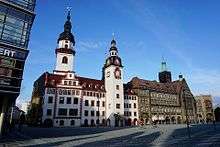 Old and new city hall
Old and new city hall Chemnitz Opera at Opernplatz
Chemnitz Opera at Opernplatz- St. Petri church
 Lutheran church
Lutheran church- Castle church over the Castle Lake
 The Mercure Hotel, tallest building in Chemnitz
The Mercure Hotel, tallest building in Chemnitz The Transparent department store
The Transparent department store View over Falkeplatz during night time
View over Falkeplatz during night time.jpg)
 Bust of Karl Marx, the city's erstwhile namesake
Bust of Karl Marx, the city's erstwhile namesake
 View over the city halls and the inner city
View over the city halls and the inner city Chemnitz-Kulturhaus
Chemnitz-Kulturhaus Watercastle Klaffenbach
Watercastle Klaffenbach- Chemnitz Stadtbad
 Guest houses at Castle park
Guest houses at Castle park Chemnitz petrified forest inside the Kulturkaufhaus Tietz
Chemnitz petrified forest inside the Kulturkaufhaus Tietz
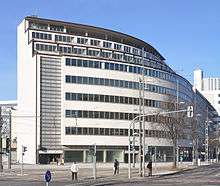 State Museum of Archaeology Chemnitz
State Museum of Archaeology Chemnitz
Urban renewal
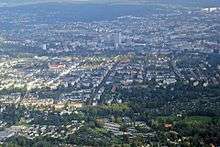
Heavy destruction in World War II as well as post-war demolition to erect a truly socialist city centre left the city with a vast open space around its town hall where once a vibrant city heart had been. Because of massive investment in out-of-town shopping right after reunification, it was not until 1999 that major building activity was started in the centre. Comparable to Potsdamer Platz in Berlin, a whole new quarter of the city was constructed in recent years. New buildings include the Kaufhof department store by Helmut Jahn, Galerie Roter Turm with a façade by Hans Kollhoff and Peek & Cloppenburg clothing store by Ingenhofen and Partner.
Economy
Chemnitz is the largest city of the Chemnitz-Zwickau urban area and is one of the most important economic areas of Germany's new federal states. Chemnitz had a GDP of about €6.3 billion in 2004. Since about 2000, the city's economy has recorded high annual GDP growth rates; Chemnitz is among the top ten German cities in terms of growth rate. The local and regional economic structure is characterized by medium-sized companies, with the heavy industrial sectors of mechanical engineering, metal processing, and vehicle manufacturing as the most significant industries.
About 100,000 people are employed, of whom about 46,000 commute from other municipalities.[23] 16.3% of employees in Chemnitz have a university or college degree, twice the average rate in Germany.
.jpg) Volkswagen is the largest employer in the Chemnitz-Zwickau Agglomeration
Volkswagen is the largest employer in the Chemnitz-Zwickau Agglomeration
 The Klinikum Chemnitz GmbH is the largest hospital in the former East German states and the second biggest employer in Chemnitz
The Klinikum Chemnitz GmbH is the largest hospital in the former East German states and the second biggest employer in Chemnitz- Chemnitz is the centerpiece of tourism in the Ore Mountains
Demography
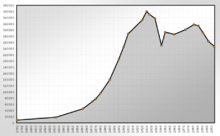
After German reunification Saxony faced a significant population decrease. Since 1990 Chemnitz has lost more than 20 percent of its inhabitants. In 2006 the BBC reported the city of Chemnitz had the lowest birth rate in the world.[24]
Number of minorities in Chemnitz by nationality 31 December 2017:
| Rank | Nationality | Population (31.12.2017) |
|---|---|---|
| 1 | 2,875 | |
| 2 | 1,225 | |
| 3 | 1,165 | |
| 4 | 1,115 | |
| 5 | 1,105 | |
A large contributor to the city's foreign population is Chemnitz University of Technology. In 2017 out of its 10,482 students, 2712 were foreign students, which equals to about 25%,[25]making Chemnitz the most internationalised of the three major universities of Saxony.
Languages
- Standard German
- Chemnitz dialect, which is a variety of Upper Saxon German[26]
Transport
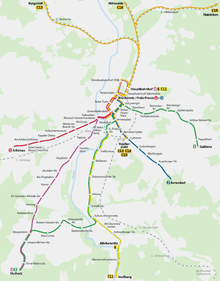
Roads
Chemnitz is crossed by the two motorways (Autobahns) A4 Erfurt – Dresden and A72 Hof – Leipzig. The motorway junction Kreuz Chemnitz is situated in the northwestern area of the city. The motorway A72 between Borna and Leipzig is still under construction. Within the administrative area of Chemnitz there are eight motorway exits (Ausfahrt).
Public transport
Public transport within Chemnitz is provided with tram and bus, as well as by the Stadtbahn. Nowadays, the city and its surroundings are served by one Stadtbahn line, five lines of the Chemnitz tramway network, 27 city bus lines, as well as several regional bus lines. At night, the city is served by two bus lines, two tram lines, and the Stadtbahn line.
The length of the tram, Stadtbahn and bus networks is 28.73 km (17.85 mi), 16.3 km (10.13 mi) and 326.08 km (202.62 mi) respectively. In August 2012, electro-diesel trams were ordered from Vossloh, to support an expansion of the light rail network to 226 km (140 mi), with new routes serving Burgstädt, Mittweida and Hainichen.[27]
Airports
Near Chemnitz there are three airports, including the two international airports of Saxony in Dresden and Leipzig. Both Leipzig/Halle Airport and Dresden Airport are situated about 70 km (43 mi) from Chemnitz and offer numerous continental as well as intercontinental flights.
Chemnitz also has a small commercial airport (Flugplatz Chemnitz-Jahnsdorf about 13.5 km (8.4 mi) south of the city. When its current upgrade is completed it will have an asphalt runway 1,400 m (4,600 ft) long and 20 m (66 ft) wide.
 Chemnitz Hauptbahnhof, the main train station of Chemnitz
Chemnitz Hauptbahnhof, the main train station of Chemnitz Tram station at Main Stadion at night
Tram station at Main Stadion at night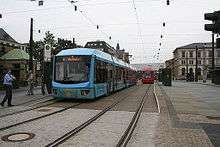 A tram in Chemnitz
A tram in Chemnitz The small commercial airport Flugplatz Chemnitz-Jahnsdorf
The small commercial airport Flugplatz Chemnitz-Jahnsdorf
Sports
- BV Chemnitz 99 (basketball, men)
- Chemnitzer FC (football)
- Chemcats Chemnitz (basketball, women)
- VfB Fortuna Chemnitz (football)
- Post SV Chemnitz (swimming)
- Schwimmclub Chemnitz v. 1892 e.V. (swimming)
- TSV Einheit Süd Chemnitz (swimming, gymnastics, volleyball, skittles)
- ERC Chemnitz e.V. (ice hockey, skater hockey)
- CTC-Küchwald (tennis)
- Floor Fighters Chemnitz (floorball)
- ESV LOK Chemnitz (luge)
- Chemnitzer EC (figure skating, ice dancing, curling)
- Chemnitz Crusaders (American football)
- Tower Rugby Chemnitz (rugby)
- SV Eiche Reichenbrand (football)
- USG Chemnitz e.V. abt Cricket Club (cricket)[28]
Famous residents
- Paul Oswald Ahnert (1897–1989), astronomer
- Brigitte Ahrens (born 1945), pop singer
- Mark Arndt (born 1941), Russian Orthodox Archbishop
- Michael Ballack (born 1976), German footballer, former captain of Bayern Munich and Germany
- Veronika Bellmann (born 1960), politician
- Fritz Bennewitz (1926–1995), theater director
- Gerd Böckmann (1944), television actor and director
- Werner Bräunig (1934–1976), writer
- Hans Carl von Carlowitz (1645–1714), forest scientist
- Max Eckert-Greifendorff (1868–1938), cartographer and professor
- Gerson Goldhaber (1924–2010), American nuclear and astrophysicist
- Friedrich Goldmann (1941–2009), composer and conductor
- Johannes Hähle (1906–1944), military photographer
- Peter Härtling (born 1933), writer
- Stephan Hermlin (1915–1997), writer
- Stefan Heym (1913–2001), writer and member of the Bundestag of the PDS
- John Kluge (1921–2010), German-American billionaire and media mogul
- Helga Lindner (born 1951), swimmer; Olympic silver medalist
- Max Littmann (1862–1931), architect
- Anja Mittag (born 1985), footballer, World Champion 2007
- Frederick and William Nevoigt, founders of the Diamant bicycle brand
- Carsten Nicolai (born 1965), contemporary artist
- Alva Noto (born 1965), sound artist
- Frei Otto (1925–2015), architect, architectural theorist and professor of architecture, builder of the Munich Olympic Park
- Sylke Otto (born 1969), luger
- Siegfried Rapp (1917–1977), one-armed German pianist
- Frank Rost (born 1973), retired football goalkeeper
- Aliona Savchenko and Robin Szolkowy, ice figure skaters: World Champion 2008, 2009, 2011, 2012, 2014; Olympic Bronze Medalist 2010, 2014
- Helmut Schelsky (1912–1984), sociologist and university lecturer
- Karl Schmidt-Rottluff (1884–1976), painter and graphic artist of expressionism
- Matthias Schweighöfer (born 1981), actor and film director
- Jörg Schüttauf (born 1961), actor
- Matthias Steiner, (born 1982), German-Austrian weightlifter, Olympic Gold Medalist 2008
- Ingo Steuer (born 1966), figure skater
- Mandy Wötzel (born 1973), figure skater
- Katarina Witt (born 1965), figure skater
- Klaus Wunderlich (1931–1997), organist
Honorary citizens
- Karl Schmidt-Rottluff (1884–1976), German expressionist painter
- Marianne Brandt, (1893–1983), artist, designer
- Stefan Heym (1913–2001), German-Jewish writer
- Valery Bykovsky (born 1934), astronaut
- Sigmund Jähn (born 1937), first German astronaut (Interkosmos flight of 26.8.1978)
Twin towns – sister cities
Chemnitz is twinned with:
|
|
References
- ↑ "Aktuelle Einwohnerzahlen nach Gemeinden 2017] (Einwohnerzahlen auf Grundlage des Zensus 2011)" (PDF). Statistisches Landesamt des Freistaates Sachsen (in German). October 2018.
- ↑ Broué, Pierre. The German Revolution: 1917 - 1923. Haymarket Books. p. 305. ISBN 1-931859-32-9.
- ↑ W. Berthold, ‘Die Kämpfeti der Chemnitzer Arbeiter gegen die militaristiche Reaktion im August 1919’, Beiträge zur Geschichte der deutschen Arbeiterbewegung, no. 1, 1962, p. 127.
- ↑ "Western Europe 1939–1945: Hamburg - Why did the RAF bomb cities?". The National Archives.
- ↑ Victor, Edward. "Chemnitz, Germany". Retrieved 23 March 2009.
- ↑ "Graduate Computing Resources - Department of Computer Science". paul.rutgers.edu.
- ↑ Travel Guide, German Democratic Republic. Dresden: Zeit im Bild Publishing House. 1983. p. 89.
- ↑ Chemnitzer Tourismus-Broschüre, Herausgeber: City-Management und Tourismus Chemnitz GmbH, 4. Jahrgang • Ausgabe 12 • Sommer 2010 Archived 26 August 2010 at the Wayback Machine.; O-Ton-Nachweis im Chemnitzer Stadtarchiv
- 1 2 Kurzfassung zur Promotion des Dipl.-Pol. Alexander Bergmann zur Thematik „Deutschlands jüngste Innenstadt – Rekonstruktion in Chemnitz verstehen“
- ↑ Dankwart Guratzsch: "Einer Stadt die Zähne herausgebrochen", Die Welt, 12 May 2006.
- ↑ Gudrun Müller: "Der Abrissrausch ist tödlich für Chemnitz", Freie Presse, 7 December 2006.
- ↑ "Chemnitz Protests Show New Strength of Germany's Far Right". Retrieved 2018-08-31.
- ↑ "German Far Right and Counterprotesters Clash in Chemnitz". Retrieved 2018-08-31.
- ↑ Connolly, Kate (2018-08-28). "German police criticised as country reels from far-right violence". the Guardian. Retrieved 2018-09-04.
- ↑ Times, Oliver Moody, Berlin | The (2018-09-02). "Germany: Weekend of riots as thousands clash at far-right march in Chemnitz". The Sunday Times. ISSN 0956-1382. Retrieved 2018-09-04.
- ↑ "Original wording: "Es gab, nach allem, was man weiss, lediglich vereinzelte Übergriffe, aber keine grossangelegte Menschenjagd (auch die NZZ hat hierüber zunächst in unzutreffender Weise berichtet)."". NZZ (in German). 2018-09-03. Retrieved 2018-09-05.
- ↑ "Sachsens Ministerpräsident Kretschmer: "Es gab keinen Mob, keine Hetzjagd" - Freie Presse - Sachsen".
- ↑ "Original wording: "65.000 bei Konzert gegen Rechts"".
- ↑ "Original wording: "Totschlag in Chemnitz: Was wir über Tatverdächtige und Opfer Daniel H. wissen"".
- ↑ "Original wording: "Die ostdeutsche Punkband Feine Sahne Fischfilet wurde jahrelang vom zuständigen Verfassungsschutz in Mecklenburg-Vorpommern beobachtet und tauchte unter dem Stichwort Linksextremismus (Rubrik: Autonome Antifa-Strukturen) in den Berichten der Staatsschützer auf."". NZZ (in German). 2018-09-03. Retrieved 2018-09-05.
- ↑ "Original wording: "27 Minuten Hass auf Veranstaltung gegen Hass"". Bild (in German). 2018-09-27.
- ↑ Chemnitz, Staatliches Museum für Archäologie. "Staatliches Museum für Archäologie Chemnitz". www.smac.sachsen.de.
- ↑ "Detlef Müller". 28 September 2007.
- ↑ "German births decline to new low". BBC NEWS. 15 August 2006. Retrieved 2 January 2010.
- ↑ "Statistical Office of Saxony, Statistical data of June 2018 for academic winter term 2017" (PDF).
- ↑ Khan, Sameer ud Dowla; Weise, Constanze (2013), "Upper Saxon (Chemnitz dialect)" (PDF), Journal of the International Phonetic Association, 43 (2): 231, doi:10.1017/S0025100313000145
- ↑ "Chemnitz orders electro-diesel tram-trains". Railway Gazette International. Retrieved 19 August 2012.
- ↑ "Chemnitz Cricket Club". USG Chemnitz e.V. abt Cricket Club. Retrieved 27 June 2015.
- ↑ "Medmestno in mednarodno sodelovanje". Mestna občina Ljubljana (Ljubljana City) (in Slovenian). Archived from the original on 26 June 2013. Retrieved 27 July 2013.
- ↑ "Miasta partnerskie – Urząd Miasta Łodzi [via WaybackMachine.com]". City of Łódź (in Polish). Archived from the original on 24 June 2013. Retrieved 2013-07-21.
- ↑ "Twin Towns". www.amazingdusseldorf.com. Retrieved 29 October 2009.
Bibliography
- See also: Bibliography of the history of Chemnitz
See also
External links



- (in German) Official website


